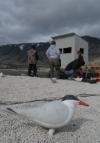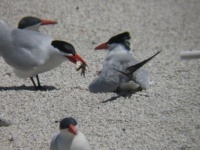 Floating Island Constructed for Caspian Tern Nesting at Summer Lake Wildlife Refuge
Floating Island Constructed for Caspian Tern Nesting at Summer Lake Wildlife Refuge
Would Caspian terns and other colonial waterbirds be attracted to nest on a floating island built to serve as nesting habitat in an area where no natural islands exist? This was a key question, but just one of several conundrums facing the organizations collaborating on this innovative project. The U.S. Army Corps of Engineers teamed up with the U.S. Geological Survey, Oregon State University, Oregon Department of Fish and Wildlife, Real Time Research, and Floating Islands International to try to make the initial breeding season for the new “Floating Tern Island” a success. Novel floating island technology was put to the test as Caspian tern nesting habitat at Summer Lake Wildlife Refuge, located in south-central Oregon and managed by the Oregon Department of Fish and Wildlife.
The plan for increasing the available nesting habitat for Caspian terns in the Pacific Region of the U.S. was developed by the U.S. Fish and Wildlife Service, in cooperation with NOAA Fisheries and the Corps of Engineers. The large Caspian tern colony on East Sand Island at the mouth of the Columbia River consumes roughly 5-6 million young salmon and steelhead annually, which limits the success of salmon restoration efforts throughout the Columbia Basin. Federal resource managers plan to redistribute part of the tern colony on East Sand Island to alternative breeding sites within their historical range by constructing tern nesting habitat in Oregon and California. One benefit of the plan for Caspian terns would be reduced vulnerability of the tern population to potential disease outbreaks, catastrophic weather events, localized predation or disturbance events, or oil spills compared to the current state of affairs, where most terns are nesting at a single colony site.
During the winter of 2008-09, two half-acre islands were built at Summer Lake Wildlife Refuge. A solid, rock-core island protected with large boulder rip-rap and covered with gravel was constructed at East Link Management Unit. A mile or so to the west at Dutchy Lake, a half-acre floating island covered with pumice gravel was launched. A third half-acre island, also rock-core construction, will be built during the winter of 2009-10 in the Gold Dike Management Unit in order to provide alternate nesting habitat for Caspian terns when the East Link impoundment is occasionally drained to manage aquatic vegetation.
.jpg) |
Caspian terns prefer bare sand nesting habitat that is clear of vegetation and provides unobstructed views of potential predators. Consequently, the Dutchy Lake floating island was covered in tree mat material to reduce weed invasion before being topped with pumice gravel. Large flat rocks were placed around the perimeter of the island to provide easy means for swimming birds to get on and off the island. Then, to attract terns to nest on the floating island, over 200 Caspian tern decoys were placed on the island, along with an audio playback system that broadcasts digital recordings of Caspian tern calls.
Dutchy Lake floating island is elliptical-shaped and secured at one end to a concrete anchor, allowing the island to rotate in the wind, much like a weather vane. As this was the first season for trying out the floating island technology, managers wondered if Caspian terns would use a floating, rotating island for nesting and, if so, would they be able to locate their nests as the island pivoted from one orientation to another? Also, how could the island be monitored for tern use and, if the island was used by nesting Caspian terns, what kind of nesting success would they have? Would nesting terns hatch their eggs and raise their young to fledging age, or would any nesting attempts end in failure? What factors would cause Caspian tern nests to fail, and could those factors be mitigated?
To help answer these questions, the collaborators on this project decided to build a wooden observation blind that would conceal field biologists while monitoring the island, and secure the blind to a small floating platform. Once the floating blind was assembled, it would be towed out to the floating island and attached so that the blind would rotate freely with the island. After several unsuccessful attempts, the floating blind was securely attached to the side of the floating island, thus providing a place for biologists to observe the colony without disturbing any birds that might decide to nest on the island.
Their questions were soon answered. In late April, Caspian terns were first sighted loafing on Dutchy Lake floating island, along with roosting ring-billed gulls, American white pelicans, Forster’s terns, and double-crested cormorants. By mid-May, the count of Caspian terns on the floating island ranged from 8 – 33 individuals and some of the terns were copulating and digging nest scrapes in the pumice substrate in preparation for egg-laying. On May 17, the first Caspian tern egg was spotted on the floating island, followed by the initiation of seven additional Caspian tern nests with eggs. The colony monitors were surprised that despite eight pairs of Caspian terns nesting on the floating island, all the ring-billed and California gulls choose to nest on the solid, rock-core island at East Link. It was as if the gulls sensed that there was something not quite right about a floating island that moves and pivots around one end. Whatever the cause, this left the Dutchy Lake floating island free of nesting gulls and the nest predation pressure that gulls frequently represent at tern colonies. The colony monitors have also observed that tern chicks tended to move freely over Dutchy Lake floating island, whereas tern chicks at other colonies with nesting gulls tend to stay close to their nest scrape and the protection of their parents due to intense predation pressure from gulls.
Re-sightings of banded Caspian terns provide some clues of where the birds using the floating island have come from. Three terns banded as fledglings at East Sand Island at the mouth of the Columbia River in 2000, 2003, and 2006 have been seen at Dutchy Lake floating island, as well as five terns banded as fledglings at Crescent Island on the Columbia Plateau in 2004, 2005, and 2006; one of the terns banded at East Sand Island was actually nesting on the Dutchy Lake floating island. A ninth banded tern that visited recently had been banded a few weeks earlier at the new Crump Lake tern island in Warner Valley. By mid July, high counts of Caspian terns on the floating island exceeded 40, as birds from other locales wandered into the Summer Lake area.
 |
-Stacy Moore (OSU) and Sarah Austing (OSU)



